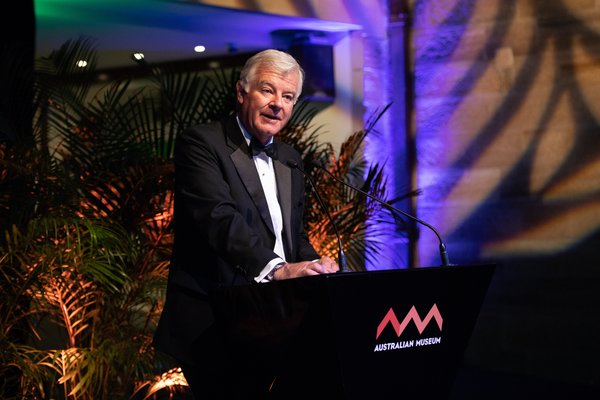Vale Chief Jerry Taki Uminduru, southern Erromango, Vanuatu
The recent passing of Chief Jerry Taki Uminduru, (1942- 2021) a Vanuatu Cultural Centre Fieldworker from southern Erromango Island, has brought great sadness to everyone who had the privilege of knowing and working with him. Chief Jerry, as he was commonly known, was a Giant Cultural Warrior, a story-teller and a living library of Erromangan history, culture and Kastom knowledge.
He was passionate in the preservation and revivalism of Erromangan culture and was actively involved in education programs with the youth. Chief Jerry began his work as a full-time Cultural Centre Fieldworker in 1984 following the accident that disabled his uncle, James Nombuat, the previous southern Erromangan Fieldworker. Chief Jerry was based in his village of Umponielongi, and travelled regularly throughout the island pursuing cultural work and attending the annual Cultural Centre Fieldworkers’ workshops in the capital, Port Vila.

© Australian Museum
Deeply connected to his people, land and culture, Chief Jerry was an outstandingly dedicated Cultural Field worker, for the VKS, working intensively during the year as part of his fieldworker’s activities; travelling, recording, documenting, promoting cultural preservation through local workshops, always focussing on elevating, reactivating old knowledge systems of history, cosmology, songs, dance, raw materials, production and rights to be passed on to future generations.
A long discussion into the early hours of the morning during the 2002 Melanesian Arts Festival being held in Port Vila, resulted in the birth of a new initiative to find support for Chief Jerry and his people to revitalise cultural practices by working with old collections of their cultural heritage at the Australian Museum.
The Erromango Cultural Revival Project was a continuation of past major cultural initiatives made by former Erromangan Fieldworkers Sempet Naritantop , James Nombuat and Kirk Huffman (Curator of the Cultural Centre’s National Museum in the capital, 1977 – end of 1989) and by women Fieldworkers (from 1994) to promote and reinvigorate Erromangan culture. This new stage (2002-2014) would further consolidate the ongoing relationship between the Vanuatu Cultural Centre and the Australian Museum.
Every aspect of this close collaboration opened up new windows of opportunity over a period of 12 years. In 2003, Sophie Nemban, the female Vanuatu Cultural Centre Fieldworker from southern Erromango came on a cultural study visit to Sydney, kindly funded with a small grant from TAMS (formerly The Australian Museum Society). This was the first time Sophie had travelled overseas and embarked in a research project studying Erromangan female cultural objects in a museum. To assist with her research project, a digital camera was given to her to document her work and personal experiences. The process and outcome of her documentation work provided the foundation to further invigorate her cultural work with Erromangan women in the following years. She later travelled extensively with her uncle, Chief Jerry, by foot and boat throughout her island helping to organise workshops, sharing her documentation and archival images from her research visit at the AM.
Sophie’s shared her cultural work experiences by attending and participating in a major international Indigenous Knowledge Symposium in Auckland in 2010.
In 2006, Chief Jerry came to the Australian Museum on a study project with the early collection of male cultural items from his island. This important work would complement and complete Sophie’s previous study and further invigorate his commitment to share old knowledge to activate the production of men’s cultural objects.

© Australian Museum
In 2008, Chief Jerry requested, via the VKS, for this writer to come and make a collection of examples of the new Erromango barkcloths to illustrate Erromangan community efforts over five years of cultural revival work. The subsequent collection made is of great significance: each barkcloth represents the first examples of barkcloth production to be made collectively by each community in over 100 years. During the time of this 2008 collection visit, the opportunity arose to film document aspects of early historical accounts of Erromangans with the outside world. The resulting 2009 film ‘Nelokopmne rises again’ (long and short versions).
In 2013, Chief Jerry contributed with Australian Museum Pacific Culture staff in organising a section of the ‘Made in Oceania: Tapa – Art and Social Landscapes’ exhibition for The Ratenstrauch-Joest Cultures of the World Museum in Cologne, Germany. The RJCW Museum curatorial exhibition team agreed to the proposal for Chief Jerry to travel to Sydney to make a selection of barkcloths and provide his own interpretation for the exhibition. He co-authored a chapter for the catalogue and co-presented with this writer in the exhibition space: “The Nevsem Dream: The Work of Lifting The example of southern Erromango, Vanuatu” in Cologne in 2014.
At the close of the above exhibition, Chief Jerry actively participated in taking down the display of Erromango barkcloths and assisted preparing and packing the objects with the AM courier to take them back to Sydney.
Chief Jerry was a cultural mentor to his people and those who had the privilege and honour to work with him over the years. His Noruwotu (knowledge/wisdom) legacy will remain in the old songs, stories and cultural continuity on his island and as a living memory within the Erromangan collections of the Australia Museum.










